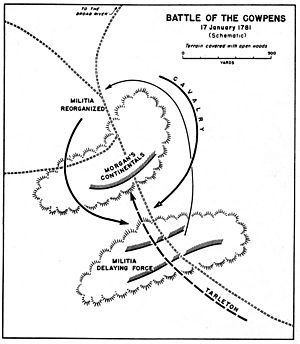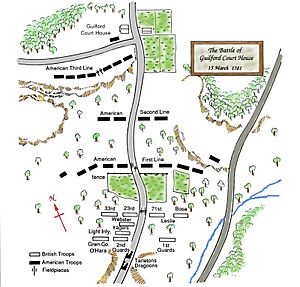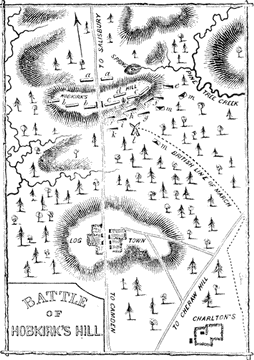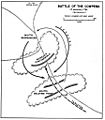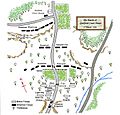John Gunby facts for kids
Quick facts for kids
John Gunby
|
|
|---|---|
| Born | March 10, 1745 Somerset County, Maryland |
| Died | May 17, 1807 (aged 62) Snow Hill, Maryland |
| Allegiance | United States of America |
| Years of service | 1775–1783 |
| Rank | Continental Army |
| Unit | Continental Army
|
| Commands held | Continental Army
|
| Battles/wars | American Revolutionary War |
John Gunby (born March 10, 1745 – died May 17, 1807) was an American soldier and farmer from Somerset County, Maryland. Many people remember him as one of the bravest officers in the Maryland Line. This was a group of soldiers from Maryland who fought in the American Revolutionary War.
Gunby joined the army as a minuteman in 1775. He fought for American freedom until the war ended. He was praised as a very skilled soldier from Maryland. John Gunby was also the grandfather of Senator Ephraim King Wilson II.
Contents
John Gunby's Early Life
The Gunby family came to Maryland from Yorkshire, England, around 1660. They first settled in Queen Anne's County. Around 1710, Gunby's grandfather moved the family to Somerset County.
They lived on a farm near Gunby's Creek, close to what is now Crisfield. John Gunby was born there on March 10, 1745. His family owned a lot of land and ships for trading. Their home was a popular meeting place for people in the area.
In the spring of 1775, when he was 30, Gunby became a minuteman. Minutemen were ready to fight at a moment's notice. His father, who supported the British, warned him that he could be hanged for treason.
Gunby's Role in the Early War
When the American Revolutionary War began, John Gunby joined the American forces. He even started his own military company and paid for it himself. This company was one of the first to be formed. Equipping and supporting these 103 men cost Gunby most of his money.
On January 2, 1776, he was chosen as captain of the 2nd Independent Maryland Company – Somerset County. In the early part of the war, Gunby's company patrolled southern Maryland. They also broke up camps of Loyalists, who supported the British. Somerset County was a strong Loyalist area.
On August 16, 1776, Gunby's company was ordered north. They joined General George Washington's army as part of Maryland's troops for the Continental Army.
Battles with the 2nd Independent Maryland Company
Gunby's company fought in several important battles. He commanded them as a captain. Then he became a lieutenant colonel on December 10, 1776. He was promoted to full colonel on April 17, 1777.
- Battle of White Plains: October 28, 1776
- Battle of Trenton: December 26, 1776
- Second Battle of Trenton: January 2, 1777
- Battle of Brandywine: September 11, 1777
- Battle of Monmouth: June 28, 1778
The Southern Campaign
After a failed attempt to capture Savannah, Georgia, the American army in the South retreated to Charleston, South Carolina. British General Sir Henry Clinton surrounded Charleston. This cut off any help for the American army.
Before surrendering, the American commander asked for help. General Washington sent General deKalb with 1,400 troops from Maryland and Delaware. The Maryland Line made up a large part of this group.
General deKalb's forces arrived in Virginia in mid-June 1780. This was almost a month after the American army in Charleston had surrendered. The Continental Congress then appointed Horatio Gates to lead the Southern Department. He took command on July 25, 1780. Gates immediately marched into South Carolina to fight the British army. The British were now led by Charles Cornwallis.
Battle of Camden
Cornwallis moved his forces to meet the Americans. The two armies fought at the Battle of Camden on August 16, 1780. This was six miles north of Camden, South Carolina. The British won a big victory because of some mistakes made by General Gates.
The Maryland troops, including Gunby's company, fought bravely even though their commander left them. They fought until they were surrounded and had to retreat. Two-fifths of the Maryland soldiers were killed or wounded. General deKalb was badly wounded and died three days later. Before he died, he praised the Maryland troops for their courage.
Battle of Cowpens
Nathanael Greene became the new commander of the Southern Department on October 5, 1780. He took charge on December 2, 1780. In early January 1781, Greene sent four companies of the 1st Maryland Regiment to help Daniel Morgan's forces.
On January 17, 1781, Morgan's strengthened army fought a much larger British force. This British force was led by Banastre Tarleton. The Americans won a major victory. Gunby was in command of his company during this battle. They charged the British 71st Regiment. The British were completely defeated. It is said that Lieutenant Colonel Howard received seven swords surrendered by British officers.
Battle of Guilford Court House
After a successful retreat, General Greene decided to fight General Cornwallis's forces. He chose the battlefield at Guilford Court House on March 15, 1781. This area is now part of Greensboro, North Carolina.
The British broke through Greene's first two lines of militia. They then threatened the third line, which included the 1st Maryland Regiment led by Gunby. The British Brigade of Guards broke through the 2nd Maryland Regiment. They captured two cannons and threatened Gunby's forces from behind. Gunby's troops were already fighting a large force led by Colonel Webster.
Gunby's command was threatened from two sides. He ordered a strong charge, and his men quickly defeated Webster's forces. Then, Gunby turned his troops to face the oncoming Guards unit. After a short exchange of gunfire, Gunby's horse was shot from under him. The 1st Maryland Regiment then charged the Guards unit, who were quickly defeated.
General Greene, who could not see this part of the battle, had already ordered a retreat. Because they were unsupported, the Maryland troops soon had to pull back.
The Battle of Hobkirk's Hill
After the Guilford Court House, Cornwallis's army was tired and needed supplies. He moved his army towards Wilmington, North Carolina. General Greene chased the British for a short time. Then he decided to take his forces into South Carolina.
Greene hoped that by threatening British bases there, he could force Cornwallis to chase him. Then Greene could fight the British on ground that was good for his army. When Cornwallis did not follow, Greene decided to reduce the British bases in South Carolina. This would force the British back into Charleston.
Greene moved his main army quickly towards Camden, South Carolina. This army included two Virginia and two Maryland regiments, plus cavalry. Lord Francis Rawdon was stationed in Camden with 900 troops. Rawdon learned Greene was coming and prepared his forces. When Greene arrived at Camden, he found his planned attack difficult. So, he moved his forces to a low, wooded ridge called Hobkirk's Hill.
On April 24, Rawdon learned from a deserter that the American artillery and militia had left Greene's main force. Rawdon decided to attack. However, on the morning of April 25, 1781, Lieutenant Colonel Carrington brought the artillery back to Hobkirk's Hill. He also brought supplies for the troops. Around 11 AM, while many soldiers were cooking, British forces were spotted. They had circled around and approached the American left side, staying close to a swamp.
The American advance pickets, led by Captain Robert Kirkwood, slowed the British. This gave Greene time to arrange his troops. Greene placed a Virginia Regiment on the far right and another to their left. On the far left, he placed the 5th Maryland Regiment. The 1st Maryland, under Gunby's command, was to their right. The cannons were in the center, with North Carolina militia behind.
Rawdon arranged his forces and slowly moved up the ridge. Greene saw that the British had a narrow front. He ordered an attack. He told the regiments on the flanks to turn and attack the British sides. He ordered the two regiments in the center to advance with bayonets. Washington's cavalry was to go around the British left and attack from behind.
During the advance of the 1st Maryland, Captain William Beatty Jr. was killed. He was commanding on the right side of Gunby's regiment. His company stopped moving forward. Gunby ordered his men to stop and fall back to reform their line. At this time, Benjamin Ford of the 5th Maryland was badly wounded. This caused his troops to become disorganized.
The Maryland troops found their flank in disarray. They were also threatened by a company of Irish troops Rawdon had brought up. The Maryland troops briefly rallied to fire a few shots. Then they left the field in disorder. Seeing this, Rawdon quickly rallied his own troops and advanced, taking control of the battlefield.
Inquiry into the Battle
The day after the Battle of Hobkirk's Hill, General Greene spoke to his troops. He made a comment that Gunby felt was aimed at him. Gunby immediately asked for a court of inquiry to review his actions. General Greene agreed to this request.
Greene believed that Gunby was the only reason the Continental Army lost at Hobkirk Hill. However, Henry Lee, also known as "Light Horse Harry," had a different opinion. In his writings about the war, Lee stated that the Maryland troops left their position. He said they did this despite the efforts of Gunby and other officers.
The inquiry did not disrespect Colonel Gunby. They noted his "spirit and activity." However, they found him at fault for making a mistake in military tactics. Both the inquiry and Greene believed that Gunby's order to his regiment to fall back and reform caused the American line to break. But this view does not consider that two companies on Gunby's right had already broken formation. They were falling back in confusion after Captain Beatty's death.
Some historians believe the entire loss of the battle was due to Captain Beatty's death. The inquiry and Greene also did not seem to accept Gunby's order to reform the line as a proper military tactic. However, Henry Lee pointed out that Daniel Morgan had used this same maneuver successfully at Cowpens.
The inquiry's report also mentioned that Gunby successfully rallied his troops. They then fired shots at the British soldiers. This suggests that the Maryland troops were not in a panic, as Greene's comments and the report seemed to imply.
Lee offered another reason for the American defeat at Hobkirk's Hill. He suggested that Greene's order for the cavalry to circle around the British and attack them from behind was a possible cause. Lee believed that if the cavalry had been kept in reserve, they could have reinforced the American line. This might have reversed the gains made by the British.
Even though both the inquiry and Greene found fault with Gunby, he remained the commander of the 1st Maryland Regiment.
Later War Service
The Maryland Line continued to fight bravely in later battles of the Southern theater of the American Revolutionary War. Gunby continued to lead the 1st Maryland Regiment.
Gunby remained commander until the regiment was dismissed and all its duties were finished. Before he resigned his position, he received a special promotion. He was made a brevet brigadier general on September 30, 1783.
Life After the War
After leaving the Continental Army, Gunby went back home to Somerset County, Maryland. His father, who died in 1788, left him a large farm. This farm was in Worcester County, Maryland, near Snow Hill. Unlike many other famous people from the war, Gunby avoided politics. He did not use his fame for personal gain.
He focused on farming. For many years, he supported at least three families of Maryland officers who were killed during the Carolina Campaigns. Gunby was also known for helping poor families build houses. He would let them pay when they could. He also helped build new roads and provided horses for those who needed them. He also contributed to the upkeep of churches. Brigadier General Gunby became an original member of the Society of the Cincinnati of Maryland.
Images for kids


